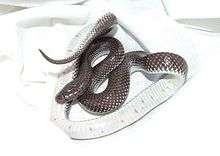Cape wolf snake
| Cape wolf snake | |
|---|---|
_(16199625893).jpg) | |
| At Lower Sabie, southern Kruger National Park | |
 | |
| Ventral aspect on an individual from Pretoria, Gauteng | |
| Scientific classification | |
| Kingdom: | Animalia |
| Phylum: | Chordata |
| Class: | Reptilia |
| Order: | Squamata |
| Suborder: | Serpentes |
| Family: | Lamprophiidae |
| Genus: | Lycophidion |
| Species: | L. capense |
| Binomial name | |
| Lycophidion capense | |
| Synonyms | |
The Cape wolf snake (Lycophidion capense) is a species of oviparous,[2] nonvenomous snake which occurs over a wide area of southern to central Africa.[3] Though docile and harmless, it may be confused with the very poisonous stiletto snake.[4]
Subspecies
The species contains three subspecies, including the nominotypical subspecies, L. c. capense.[1]
- Lycophidion capense capense (A. Smith, 1831)
- Lycophidion capense jacksoni (Boulenger, 1893)
- Lycophidion capense loveridgei Laurent, 1968
Nota bene: A trinomial authority in parentheses indicates that the subspecies was originally described in a genus other than Lycophidion.
Description
Adults regularly reach 40 cm in length,[4] but some grow to 64 cm. It has a flattened, tapering head and marbled eye. The brown or black lateral and dorsal scales are tipped white,[5] while the ventral scales are all-white. Long recurved fangs are present on the upper as well as lower jaws,[4] for which they are named.
Diet and behaviour
They are widely distributed but prefer damp locations,[4] with lowland forest and fynbos being preferred habitats. They feed mostly on geckos and skinks which they bite and kill by constriction.[2] They are believed to reach an age of 15 to 20 years.[5]
References
- 1 2 3 Lycophidion capense at the Reptarium.cz Reptile Database, 2007
- 1 2 Carruthers, Vincent (2005). The Wildlife of Southern Africa: A Field Guide to the Animal and Plants of the Region. Cape Town: Struik Publishers. p. 92. ISBN 1-86872-451-4.
- ↑ Biodiversity occurrence data provided by GBIF: (Accessed through GBIF Data Portal, www.gbif.net, 2008-09-02)
- 1 2 3 4 "This is a Wolf... snake". Facebook. Bionerds.co.za. Retrieved 15 May 2018.
- 1 2 "Lycophidion capense (Common wolf snake, Cape wolf snake)". biodiversity explorer. iziko museums. Retrieved 15 May 2018.
Further reading
| Wikimedia Commons has media related to Lycophidion capense. |
- Boulenger GA. 1893. Catalogue of the Snakes in the British Museum (Natural History). Volume I., Containing the Families ... Colubridæ Aglyphæ, part. London: Trustees of the British Museum (Natural History). (Taylor and Francis, printers). xiii + 448 pp. + Plates I-XXVIII. (Lycophidium capense, pp. 339–340; Lycophidium jacksoni, new species, p. 340 + Plate XXI, figure 3).
- Branch, Bill. 2004. Field Guide to Snakes and other Reptiles of Southern Africa. Third Revised edition, Second impression. Sanibel Island, Florida: Ralph Curtis Books. 399 pp. ISBN 0-88359-042-5. (Lycophidion capense, p. 76 + Plate 36).
- Smith A. 1831. "Contributions to the Natural History of South Africa, &c". South African Quarterly Journal 1 (5): 9-24. (Lycodon capensis, new species, p. 18). (in Latin and English).